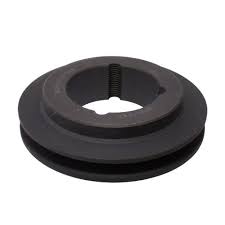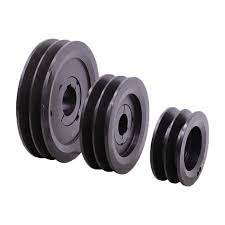Product Description
V-grooved Taper Bushed Pulley
Type: SPA, SPB, SPC, SPZ
Size: 50~ 1250
Materials: HT250( C45 steel optional)
| Groove Profile |
WP | b | t | e | f | PD | Angle aº |
g |
| SPZ | 8.5 | 2.0 | +0.6 11.0 0 |
12±0.3 | 8.0±0.6 | ≤80 | 34±1 | 9.72 |
| >80 | 38±1 | 9.88 | ||||||
| SPA | 11.0 | 2.8 | +0.6 13.8 0 |
15±0.3 | 10.0±0.6 | <118 | 34±1 | 12.68 |
| >118 | 38±1 | 12.89 | ||||||
| SPB | 14.0 | 3.5 | +0.6 17.5 0 |
19±0.4 | 12.5±0.8 | ≤190 | 34±1 | 16.14 |
| >190 | 38±1 | 16.41 | ||||||
| SPC | 19.0 | 4.8 | +0.6 23.8 0 |
25.5±05 | 17.0±l | ≤315 | 34±0.5 | 21.94 |
| >315 | 38±0.5 | 22.31 |
/* March 10, 2571 17:59:20 */!function(){function s(e,r){var a,o={};try{e&&e.split(“,”).forEach(function(e,t){e&&(a=e.match(/(.*?):(.*)$/))&&1
| Certification: | ISO |
|---|---|
| Pulley Sizes: | SPA,Spb,Spz, Spc |
| Manufacturing Process: | Casting |
| Material: | Ht250, or C45 |
| Surface Treatment: | Phosphating Treatment |
| Application: | Chemical Industry, Grain Transport, Mining Transport, Power Plant, Oil Insutry |
| Samples: |
US$ 0/Set
1 Set(Min.Order) | |
|---|
| Customization: |
Available
| Customized Request |
|---|

What are some real-world examples of spa pulley applications in spa equipment?
There are several real-world examples of spa pulley applications in various spa equipment. Here’s a detailed explanation of some common examples:
1. Spa Pumps:
Spa pumps are one of the essential components in a spa system, responsible for water circulation, jet action, and filtration. Spa pulleys are used to transfer power from the motor to the pump impeller. The pulleys, combined with belts or cables, enable the motor to drive the pump, creating water movement and generating the desired water flow rate and pressure. Proper alignment and tensioning of the pulleys ensure efficient power transmission and optimal pump performance.
2. Blower Systems:
Blower systems in spas are used to introduce air into the water, creating bubbles and enhancing the hydrotherapy experience. Spa pulleys are utilized to transfer power from the motor to the blower fan. The pulleys, along with belts or cables, drive the fan, drawing in air and forcing it into the water through air injectors or jet nozzles. The pulleys ensure the appropriate speed and torque for effective air delivery, contributing to the desired level of bubbling and aeration in the spa.
3. Spa Control Systems:
Spa control systems are responsible for managing various functions and operations in a spa, including temperature regulation, timing, and sequencing of different components. Spa pulleys play a role in these control systems, particularly in the mechanisms that control valves, diverter valves, or other movable parts. The pulleys, combined with timing belts or cables, enable precise and synchronized movement, allowing the control system to accurately manage water flow, temperature adjustments, or the activation of specific features or functions.
4. Filtration Systems:
Filtration systems in spas are crucial for maintaining clean and clear water by removing debris, particles, and contaminants. Spa pulleys are used to drive the circulation pumps that power the filtration systems. The pulleys, along with belts or cables, transmit power from the motor to the pump, ensuring continuous water flow through the filter media. Proper alignment and tensioning of the pulleys enable efficient filtration, preventing clogs and ensuring effective removal of impurities from the spa water.
5. Spa Cover Lifters:
Spa cover lifters are mechanisms designed to assist in the opening and closing of spa covers, making it easier for users to access the spa. Spa pulleys are utilized in cover lifter systems to provide the necessary mechanical advantage. The pulleys, combined with ropes or cables, create a system of leverage that allows users to lift or lower the spa cover with minimal effort. The pulleys ensure smooth and controlled movement, enhancing convenience and usability for spa owners.
6. Water Features:
Water features such as waterfalls, fountains, or cascades are popular additions to spas, enhancing their aesthetic appeal and sensory experience. Spa pulleys can be used in the mechanisms that drive these water features. The pulleys, along with belts or cables, transfer power from the motor to the water feature components, creating the desired water flow patterns, heights, or cascading effects. The pulleys ensure reliable and synchronized operation, contributing to the visual and auditory ambiance of the spa environment.
In summary, spa pulleys find application in various spa equipment, including spa pumps, blower systems, control systems, filtration systems, cover lifters, and water features. They enable efficient power transmission, precise movement, and reliable operation of these components, contributing to the overall functionality, performance, and user experience in a spa.

What maintenance procedures are necessary to ensure the reliability of spa pulleys?
Maintaining the reliability of spa pulleys requires several essential maintenance procedures. Here’s a detailed explanation of the necessary steps:
1. Regular Inspection:
Perform regular visual inspections of the spa pulleys to check for any signs of wear, damage, or misalignment. Look for cracks, chips, or excessive wear on the pulley surfaces. Additionally, inspect the belt or cable for any signs of fraying, stretching, or deterioration. Regular inspections help identify potential issues early on and allow for timely maintenance or replacement of the pulleys if necessary.
2. Cleaning:
Keep the spa pulleys clean and free from debris, dirt, or contaminants that may accumulate over time. Use a soft brush or cloth to remove any build-up around the pulley grooves or teeth. Clean pulleys help maintain proper belt or cable engagement and reduce the risk of slippage or premature wear. Avoid using harsh chemicals or abrasive materials that could damage the pulley surfaces.
3. Lubrication:
Proper lubrication is crucial for ensuring smooth operation and minimizing friction between the pulleys and the belt or cable. Consult the manufacturer’s recommendations or guidelines for the appropriate lubricant to use. Apply the lubricant sparingly and evenly to the pulley surfaces, taking care not to over-lubricate. This helps reduce wear, heat generation, and noise, enhancing the overall reliability and lifespan of the pulleys.
4. Tension Adjustment:
Regularly check and adjust the tension of the belts or cables connected to the spa pulleys. Proper tensioning is essential for efficient power transmission and preventing slippage. Refer to the manufacturer’s guidelines for the recommended tension levels and adjustment procedures. Use the appropriate tools, such as tension gauges or adjusting mechanisms, to achieve the desired tension. Ensure the tension is evenly distributed across the belt or cable to prevent uneven wear or premature failure.
5. Belt or Cable Replacement:
If the belts or cables show signs of significant wear, stretching, or damage, they should be promptly replaced. Worn or damaged belts or cables can affect the performance and reliability of the spa pulleys. Follow the manufacturer’s recommendations for the correct type, size, and installation procedure of the replacement belts or cables. Proper installation ensures optimal engagement and power transmission, maintaining the reliability of the spa pulleys.
6. Balancing:
In some cases, spa pulleys may require balancing to minimize vibration and ensure smooth operation. If excessive vibration or noise is observed during operation, it may indicate an imbalance in the pulleys. Consult a professional technician or follow the manufacturer’s instructions for balancing the pulleys. Balancing procedures typically involve adding or removing weight from the pulley to achieve proper balance and improve the reliability of the pulley system.
7. Preventive Maintenance:
Implement a preventive maintenance schedule for the spa pulleys. This may include periodic maintenance tasks, such as inspections, cleaning, lubrication, and tension adjustment, as well as any other specific maintenance requirements recommended by the manufacturer. Following a preventive maintenance plan helps identify and address potential issues before they escalate, ensuring the long-term reliability and performance of the spa pulleys.
By following these maintenance procedures, spa owners can ensure the reliability and longevity of their spa pulleys. Regular inspections, cleaning, lubrication, tension adjustment, belt or cable replacement, balancing, and preventive maintenance all contribute to maintaining optimal performance and minimizing downtime or costly repairs.

What are the benefits of using spa pulleys for various components in a spa?
Using spa pulleys for various components in a spa offers several benefits. Here’s a detailed explanation of the advantages of using spa pulleys:
1. Efficient Power Transfer:
Spa pulleys provide an efficient means of power transfer from the motor or drive source to various components within the spa. By utilizing pulleys, rotational power can be transmitted smoothly and effectively, ensuring optimal performance of the driven components. This efficiency helps in achieving reliable operation and maximizing the functionality of the spa system.
2. Adjustable Speed and Torque:
Spa pulleys, when combined with different pulley ratios or sizes, allow for speed and torque adjustments in the driven components. By changing the pulley configuration, the rotational speed or torque output can be modified to meet specific requirements. This flexibility enables customization of the spa system, accommodating different water flow rates, jet intensities, or other operational preferences.
3. Noise Reduction:
Spa pulleys, particularly when used with belts or cables that offer good shock absorption properties, help in reducing noise during operation. Vibration and noise produced by the motor or drive source can be dampened by the use of pulleys, resulting in a quieter spa experience. This is especially important for those seeking a tranquil and relaxing environment while using the spa.
4. Enhanced Component Durability:
By employing spa pulleys, the load on the driven components, such as pump impellers or blower fans, is distributed more evenly. This helps to reduce stress and wear on individual components, leading to enhanced durability and longevity. The use of pulleys can help protect critical components from excessive strain, ensuring their reliable performance over time.
5. Reliable Water Circulation and Jet Operation:
Spa pulleys play a crucial role in facilitating water circulation and jet operation within the spa system. By transferring rotational power to the pump impeller, the pulleys ensure efficient water movement and proper jet performance. This reliable circulation and jet operation contribute to the overall effectiveness of the spa’s therapeutic effects, providing a satisfying and enjoyable experience for users.
6. Easy Maintenance and Replacement:
Spa pulleys are generally designed to be easily accessible and serviceable. This makes maintenance tasks, such as belt adjustments or replacements, more convenient. When a belt or pulley needs to be replaced, it can typically be done without requiring extensive disassembly of the spa system, saving time and effort.
Overall, the use of spa pulleys offers benefits such as efficient power transfer, adjustable speed and torque, noise reduction, enhanced component durability, reliable water circulation, and easy maintenance. These advantages contribute to the smooth operation, performance, and longevity of the various components within a spa system, ensuring a satisfying and long-lasting spa experience for users.


editor by CX
2024-01-10